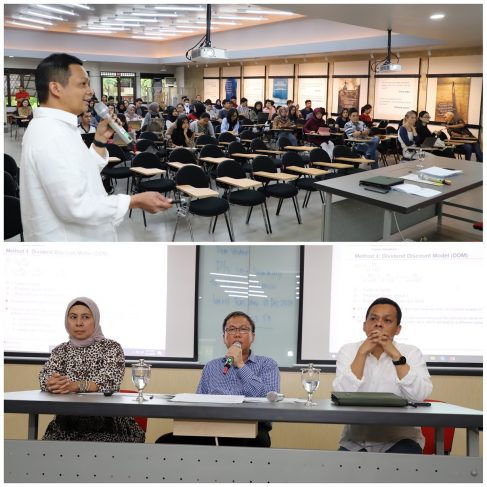Accounting Department FEB UI Invited Practitioners to Shaere Experiences in Business Analysis and Valuation
Nino Eka Putra ~ Humas FEB UI
DEPOK – In increasing students’ knowledge of the subject of analysis and the use of financial reports, the Department of Accounting FEB UI held a Guest Lecturer Lecture from practitioners who are experts in their fields with the theme “Business Analysis and Valuation” and took place at the Student Center, on (7/12) / 2019).
President Director ad Interim PT. Danareksa Sekuritas, Budi Susanto, said that bond valuation is based on the concept of Time Value of Money, such as the payment of interest or kopun which is treated like a fixed cash flow (fixed period). Cash flow generated each period by bonds will be discounted based on the required rate of return / IRR / discount rate / YTM (Discounted Cash Flow method).

Determination of the amount of yield requested by investors is determined by macroeconomic conditions, yields / yields on government bonds, interest rates (Bank Indonesia & banking), time period, credit rating instruments, guarantees, and sector/industry.
“Measurement of market risk (duration) is one function that can be used to analyze the price volatility of bonds. Its usefulness, shows the approximation of the percentage rate of change in the price of the bond to the change in the interest rate / yield. The relationship between the value of the duration of the coupon with interest & the length of maturity of the bonds include the higher interest coupon – the smaller the duration, the higher the yield – the smaller the duration, and the longer the maturity – the greater the duration,” said Budi Susanto.
Simply put, the duration can be used as part of risk management for tools to carry out a process of matching assets and liabilities as well as tools for immunization of investment sensitivity to interest rate movements. Meanwhile, the macaulay duration is the weighted average of the periods until the bondholders receive cash flow from the bonds. Bonds that pay coupons regularly have a coupon payment schedule, for example 1 year from the settlement date, 2 years from the settlement date, and so on until the maturity of the bonds.
“Modification of duration can be obtained by using YTM for 1 period coupon. In addition to these methods, it can also be obtained through changes in bond prices compared to real changes, “he added.
On the other hand, the rating is an independent opinion about the company’s ability to pay off its financial obligations on time and the amount that reflects the relative credit strength of an issuer / issuer and is not a recommendation to buy, sell or hold a bond.
Meanwhile, it gives an indication of the likelihood of investors recovering their investors as promised but does not provide specific predictions of the probability of default. “Thus, business risks will occur in asset profile & quality, cost & operating management, customer base, diversification & operation stability, economy of service areas, management & corporate strategy, market position, marketing & distribution, and regulation,” he said.
Managing Director of PT. Bahana PUI (Persero), Marciano Hersondrie Herman, added that the value is divided into 4 parts, namely fair market value is the amount where the property will change hands between buyers & sellers who are willing when there is no compulsion to buy / sell & when both have reasonable knowledge about relevant facts. Fair value is the standard value according to the law provided specifically in matters that distinguish shareholders in most states. Investment value is the value for a particular investor based on individual investment requirements, which are distinguished from the concept of market value that is personal & separate. Intrinsic value is a value based on the perceived characteristics inherent in an investment, not angry with characteristics that are typical for an investor.

The business valuation method is based on the approach used for the availability of data/assumptions, common practices and conformity to the type of industry and other factors according to the characteristics of the target company & the level of analysis needs.
“This method is classified into 3 parts, including an income approach that discounts future cash flow projections to evaluate investment potential & measure the intrinsic value of a company’s business. Asset approach that focuses on assets used in the company’s business, net asset value does not take into account intangible assets, business potential, market presence, and premium brands. The market approach uses comparable company analysis using the main financial ratios & multiples of trades of similar public companies, and multiples of valuation using benchmarks of previous similar transactions,” he concluded. (Des)











